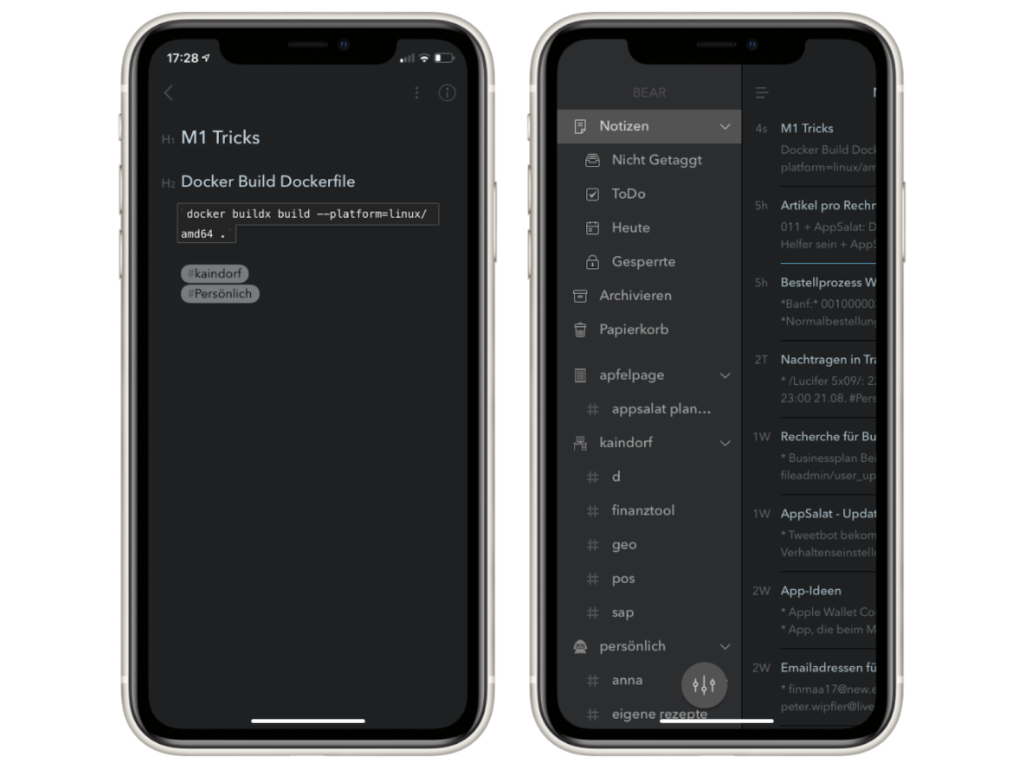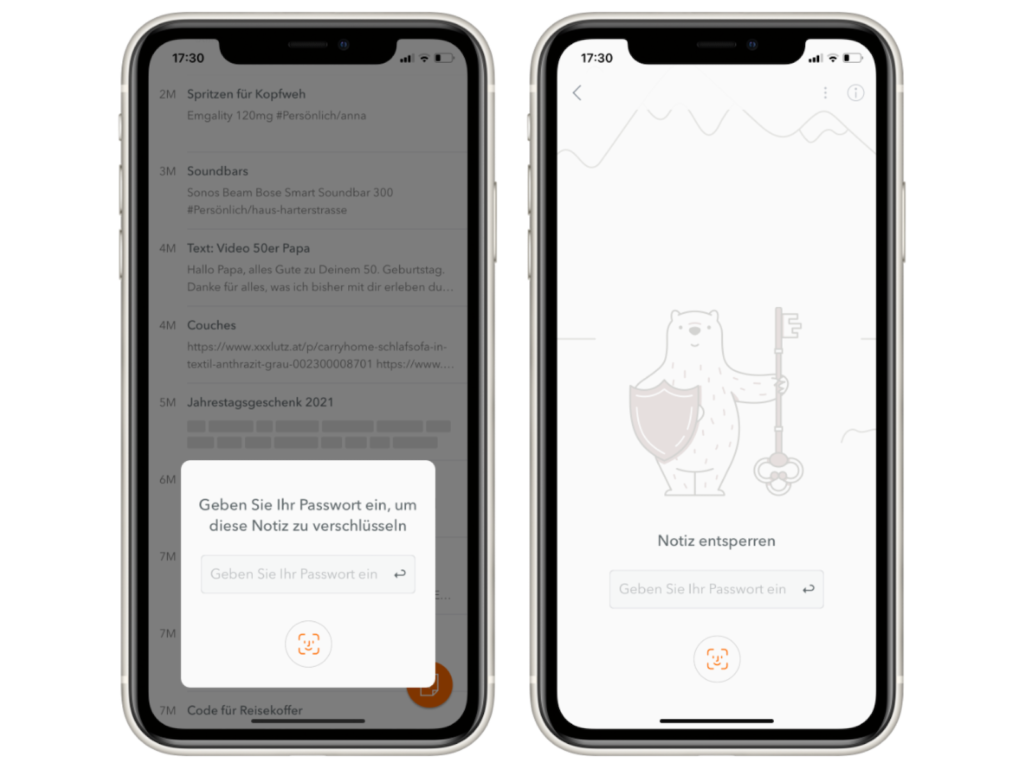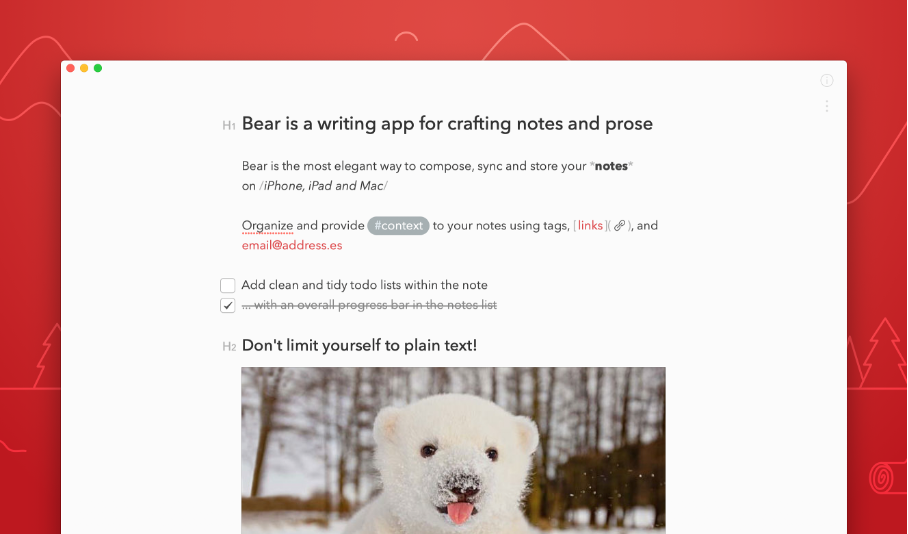Are you bored with Apple's Notes app? Don't worry, there are plenty of other options out there - for example Bear. Today we'll introduce you to five features that make the app special.
Bear is a note-taking app for iOS, iPadOS, watchOS and macOS - nothing earth-shattering so far. However, the developers have integrated many things that make it different from the pre-installed note-taking app. Below we show you the five most exciting features of Bear.
tagging system
In Bear, notes are managed using so-called tags, which can be thought of as folders in the Files app or Finder. Assigning a note to a tag is really simple; you just write a hash symbol (“#”) anywhere.

You have a lot of flexibility when using tags. You can place them anywhere in the note, which allows you to create an even finer structure in your notes. They can also be nested, which has the advantage that large areas can be divided into small sections if necessary. Bear also comes with some predefined tags:
- Untagged contains all items without a tag
- Notes in To Do have at least one checkbox
- Today includes everything that was created or last edited today
- Locked includes all notes that have been locked with a password and Touch ID or Face ID.
And thanks to iCloud, the entire structure is synchronized between all devices.
encryption
Bear allows you to protect individual notes with a password and Touch ID or Face ID. A strong password is required for this, and a password hint can also be entered optionally. If you now want to view a locked note, verification is necessary. The process is described in more detail here. This is what the end user sees.

However, there is a complicated encryption process behind it that Bear created together with the security experts at Cossack Labs. An important component of this is the "Secure Enclave". Since the data is handled in a completely separate area, it is more difficult for hackers to access it.
Secure Enclave: This is the mini-processor of Apple devices (or part of the main processor in the M1 and A processors) on which sensitive data is processed. In Macs with an Intel chip, these are the T1 and T2 chips.
Two other important parts are the iCloud keychain and the generation of AES-GCM-256 keys. When assigning the password, another secret key is generated, which must also be present when accessing the locked note. This is done automatically, so you don't have to do anything in this regard. This may sound complicated for the average user - in the end it simply means that the content in Bear is really safely stored. If you are interested in the topic, you can find further details in the article by Cossack Labs.
High adaptability
In Bear you can edit pretty much every aspect of the appearance. This starts with the themes. On the one hand, these are relatively common, such as "High Contrast" or "Dark Graphite", but on the other hand there are also more unusual variants, such as "Panic Mode" or "Solarized Dark". If you want, the app icon also adapts to the selected color scheme. The typography can also be adjusted to your own wishes. In addition to the font size, line height and paragraph spacing, you can also choose a font. Avenir Next is active by default, otherwise there is also:
- Helvetica Neue
- Menlo
- Georgia
- Courier
- Open Dyslexic
Taking notes with Markdown
In Bear, notes are created using a modified version of Markdown. But what is that? Markdown was developed to enable documents to be formatted quickly, easily and consistently. In addition, thanks to Markdown, it is possible to recognize the final format of a document (for example, a blog post for a website) before it is published.

Formatting works by placing certain characters around the text areas provided. For example, "_Hello Apfelpatient!_" formats the greeting in italics. You also get a little help to get you started. In the editor view, there is an area where you can select the formats with a click. The so-called "backlinks" are also useful. By inserting two square brackets and writing the title of a note, a link to it is created. Attachments in the form of images, documents or PDFs are also accepted by the editor. These are displayed nicely within the document. By the way, a preview is displayed with a click. Drawings can also be attached. These can be created with the Apple Pencil or with your finger.
export options
Once the text has been entered for the first time, it is possible to export the results. The appropriate file format should be available for each intended use. The formats include:
- plain text
- Markdown
- JPG
- HTML
- RTF
- and Word.
We like the fact that the font and all other properties of the document are retained in the export. This gives you a lot of flexibility when it comes to sharing your notes.
Bear: Conclusion
Bear is probably the best designed note app in the App Store. It's not for nothing that the app won a design award from Apple. In addition, Bear's appearance can be completely customized to your own wishes using themes. We also liked the adaptability of the text area. Creating and formatting notes is very quick and easy using Markdown. Whether you're a Markdown pro or a newbie, everyone should be able to get along well with the writing area. You can get Bear for iOS, watchOS, iPadOS and macOS as a free downloadFor 1.49 euros per month or 15.99 euros per year you can activate synchronization with iCloud, all available themes and the numerous export options. (Image: Bear)





